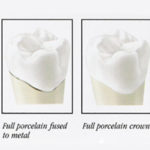When a filling is over 60% the surface of the tooth or after a root canal is completed, a crown is recommended. Large fillings do not flex and respond the same as the natural tooth enamel during chewing and grinding. As a result, the margin where the filling meets the tooth is the most susceptible to opening up, leaking and causing decay to reoccur on the tooth. The large the filling, the more flexibility it has and the worse the leakage. We have seen large fillings we have had to replace every 2 years and eventually there is not enough tooth left to support a crown and we cannot save the tooth.
When a filling is over 60% the surface of the tooth or after a root canal is completed, a crown is recommended.
During a root canal, the center of the tooth is removed to access and clean out the dying or dead nerve. If the tooth had a large cavity or previous filling that caused the nerve to die, this also decreases the amount of tooth structure remaining. After the root canal is completed, the tooth loses its vitality and becomes very dry and prone to fracture. For these reasons, a crown is recommended to help replace the missing tooth structure and hold the tooth together to prevent fracture, and possible tooth loss.
Crown options range from most esthetic to least esthetic. Full Porcelain crowns are the most esthetic, but also need the most amount of tooth reduction to make the porcelain strong. There is also a crown material called Zirconia that has esthetic properties close to porcelain and strength close to a metal that can be placed on the back teeth. This is ideal for a patient who clenches or grinds their teeth but does not want a traditional metal crown. Porcelain fused to metal (PFM) crowns have a metal substructure that wraps around the tooth for strength and porcelain baked on top for esthetics. These crowns are not as translucent (meaning they do not reflect light like natural teeth) and thus are not as esthetically pleasing. Along the gum line on these crowns, there is also a gray line visible from the metal that shows through. We have had many patients mistake for decay, but it is just the natural of these types of crowns. Lastly there are full good crowns. These are much more expensive than tooth colored crowns but also require the least amount of tooth reduction and are the strongest. There is a reason they call it the “gold standard”. They are also gold colored and not esthetic – unless of course, you are a pirate.
Gold and metals are also very good thermal conductors where they transmit hot and cold temperatures readily. Patients usually experience a period of a few weeks to a few months where temperature is felt on these new crowns more so than the natural teeth and this should subside with time.







